English Heritage recently launched a campaign entitled ‘Save our Story’. The ‘story’ to be saved is in reality made up of innumerable stories, recounted in paint on the walls and ceilings of secular and religious buildings throughout England. And, as the organisation has stated, ‘Restoring these precious wall paintings is like drawing back the curtain on the lives of those who shaped who we are.’ A map on the English Heritage site flags 84 places where wall paintings in buildings that come under its protection are located. They make up the largest collection of wall paintings in the country, ranging from a 1st century Roman fresco at Lullingstone Villa in Kent to graffiti etched on the walls of a cell block at Richmond Castle in Yorkshire by conscientious objectors imprisoned there during the First World War.
These, however, represent only a small sampling of the fragments that can be found in many other buildings throughout the country (the Courtauld’s survey of historic wall paintings in the British Isles, coordinated by David Park, provides a comprehensive picture, while Roger Rosewell’s book Medieval Wall Paintings contains an appendix that lists, county by county, churches and other buildings containing significant pre-Reformation survivals); in addition, there may be more yet to be uncovered. All are potentially in danger from renovation building work and damaging climate conditions, as well as, at times, a lack of awareness of their importance.
English Heritage has marked out 76 of its sites for conservation over the next five years. Climate conditions such as water ingress or humidity are common causes of damage – at Lullingstone, for example, microbial growth caused by high relative humidity has affected the painted surface of its trio of water nymphs. But original materials – the kind of masonry or mortar used, for instance – can also be culpable, as can the addition of wax coatings and other ‘conservation’ techniques from previous eras. Deliberate historic damage, of course, particularly post-Reformation, is also a factor. In 1550, under Edward VI, the defacing of images was enshrined in law. Ironically, however, the systematic whitewashing of so many medieval wall paintings had the unintended effect of preserving them (unlike stained-glass windows, which could be smashed, and mobile objects such as sculptures, altarpieces, and chalices, which could be destroyed or melted down). One such example, arguably the jewel in English Heritage’s crown of wall paintings, is the church of St Mary’s in Kempley, Gloucestershire. Uncovered in the 19th century, the early 12th–century paintings in its chancel, incorporating a vision of Christ at the Apocalypse, are the most complete set of Romanesque frescoes in northern Europe.
Every wall painting encapsulates its own story or history of how and why it was made, and by and for whom. If, as often happened, it was subsequently covered over there is the further element of its rediscovery. Many medieval and Renaissance wall paintings functioned as simple ways of decorating blank masonry in order to make interiors more attractive and homely; the alternative of commissioning wall hangings or tapestries was a far slower and more expensive option. Decorative motifs range from geometric and other shapes such as chequerboards (as at Kempley), chevrons, diamonds, lozenges and medallions, to foliate patterns, scrollwork and heraldry. Sometimes fictive textile hangings or tapestries with landscapes showing birds and other animals on meadows of flowers and other trompe-l’oeil effects helped to open up spaces and convey perspective.
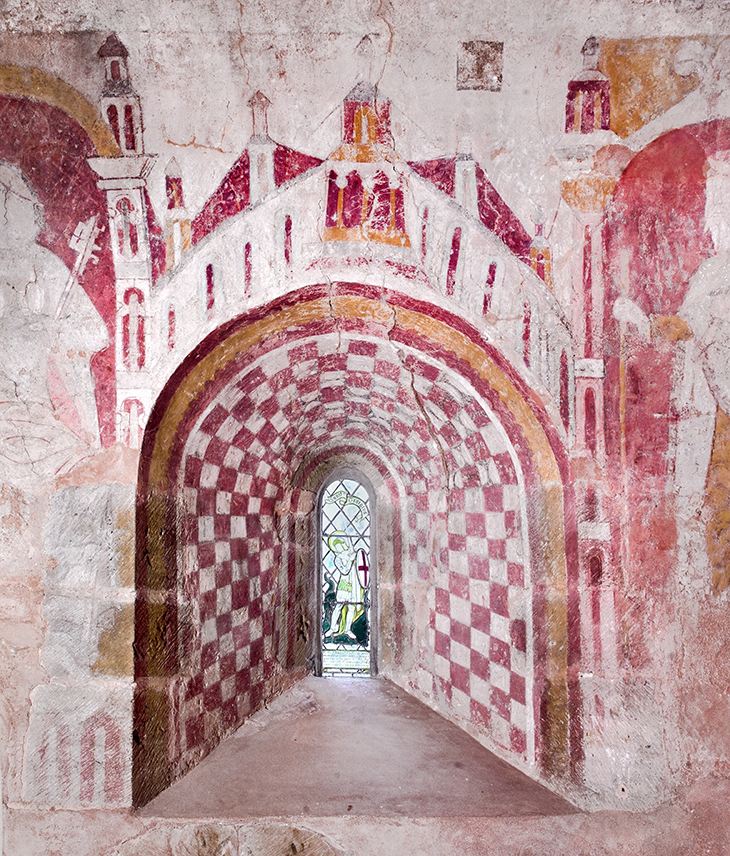
A chequerboard pattern surrounds a chancel window at St Mary’s Kempley, with a representation of the gates of Jerusalem above. Photo: English Heritage
Representational paintings in churches were usually devotional or didactic. Among figurative subjects are saints (St George and St Catherine are particularly common), and biblical scenes such as the Last Judgement and Annunciation (very often found on either side of the chancel arch), the Adoration of the Magi and Christ’s Passion, as well as moral and mythological subjects. Scenes of everyday life in secular buildings are far less common. One of the most remarkable discovered in recent years is a school scene covering an entire wall of the Head Master’s Chambers at Eton College. Painted around 1520, the scene shows a schoolmaster seated on a cathedra, holding his attributes of birch and book, flanked by pupils on forms and stools reading from shared books. While one pupil writes with a stylus on a tablet, a junior boy, with his inkwell and penner attached to his belt, enters the class playing with his whipping top. Added to the composition are numerous inscriptions from the classical authors whose works formed the staple curriculum of humanist education at the time. This painted scene, covered over with lime wash possibly only a decade or so after it commissioned by the head master of the time, had lain hidden from sight for almost five centuries. It was revealed by chance when a section of early 18th-century panelling covering the walls of the room came loose and exposed the feet of one of the schoolboys through the lime wash beneath.
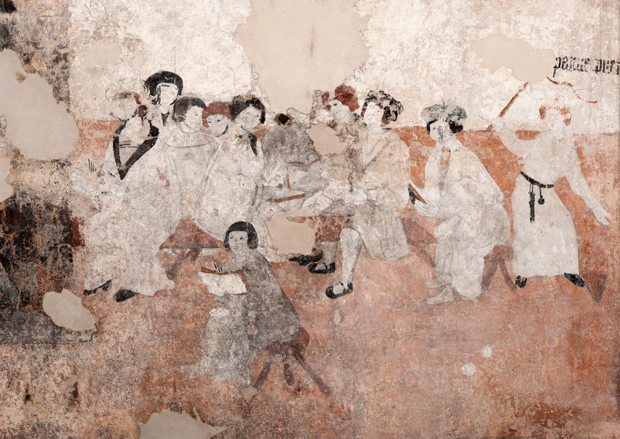
A group of schoolboys at their lesson, detail from a wall painting in the Head Master’s Chambers, Eton College. Photo: James Davies; reproduced by permission of the Provost and Fellows of Eton College
Another story of accidental discovery surrounds the extensive 15th-century Flemish-style mural depicting the Miracles of the Virgin decorating the walls of the medieval chapel at Eton. Whitewashed by the college barber in 1560, it was accidentally rediscovered in 1847 and partially destroyed, before being covered up once again by wooden seating. It was in 1881 that the school boy M.R. James, future medieval scholar and writer of ghost stories, glimpsed two spectral figures in white robes when a section of the stalls was briefly removed. Thanks to his intervention when he was subsequently provost of the College, the remaining paintings were exposed and conserved.
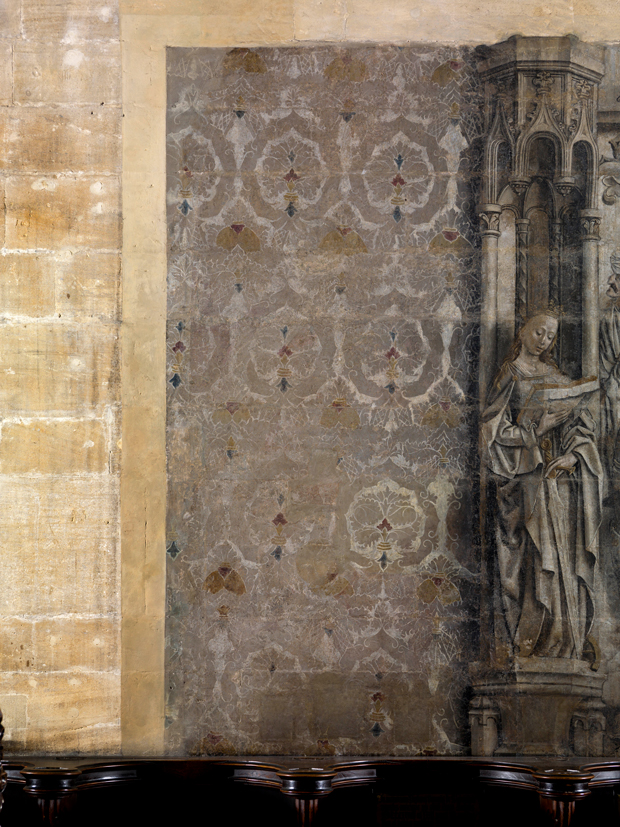
Fictive hanging with pomegranate motif, Miracles of the Virgin, in Eton College Chapel. Photo: James Davies; reproduced by permission of the Provost and Fellows of Eton College
Such stories of the vicissitudes and chance discovery of wall paintings in this country reveal their extreme vulnerability. They emphasise that what we see now are only fragments of what was once a usual form of decorating building interiors. It is these fascinating and often beautiful remaining fragments – ‘irreplaceable treasures’ of England’s heritage – whose stories we must save from vanishing for ever.
Find out more about English Heritage’s ‘Save Our Story’ campaign here.
Henrietta McBurney is co-author of Wall Paintings of Eton (Scala Publishers).
Unlimited access from just $16 every 3 months
Subscribe to get unlimited and exclusive access to the top art stories, interviews and exhibition reviews.





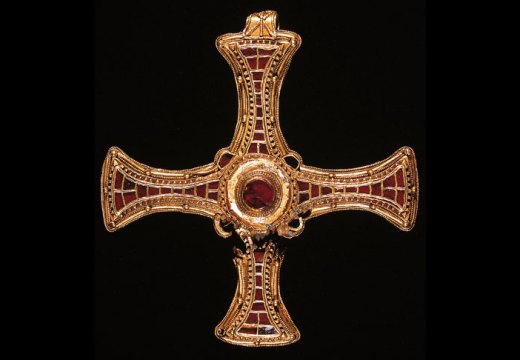
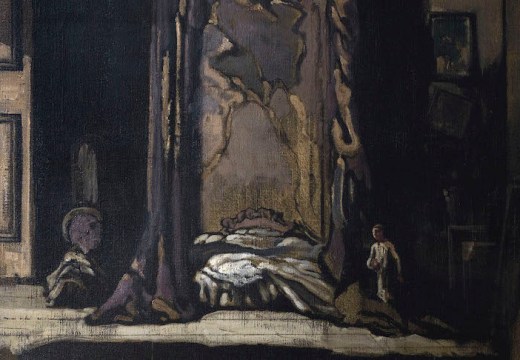









![Masterpiece [Re]discovery 2022. Photo: Ben Fisher Photography, courtesy of Masterpiece London](http://www.apollo-magazine.com/wp-content/uploads/2022/07/MPL2022_4263.jpg)
It’s time for the government of London to return to its rightful home